
Makers Snapshot
Location: Northern Hhohho, ESwatini (formerly known as Swaziland)
Established: 1985
Founder: Sheila Freemantle
Number of Workers: Trained and worked with over 1400 women since it began
Products: Jewellery and baskets
Materials: Sisal, Lutindzi grass, sterling silver
Values: Fair Trade, empowering women, supporting artisans in rural areas, sustainability, handmade
About Tintsaba
Tintsaba (Tints-sarba) is a social enterprise in Eswatini / Swaziland that specialises in hand-crafted baskets and jewellery made from sisal. The name translates to "mountains" in the local language of Piggs Peak, Eswatini. Founded in 1985, the organisation began with the goal to help Swazi women in rural areas to achieve financial independence. Since it began, Tintsaba has worked with and trained over 1400 women.
Tintsaba has always had a holistic approach to women's empowerment, fostering growth in the women's careers while also providing opportunities for capacity building. They run workshops and courses on a number of topics including leadership, skill-set development, literacy, sustainability and women's health. Through learning these skills and earning their own income, the women and their families are able to escape the cycle of poverty.

The Material - Sisal
Sisal is a species of the agave plant that is native to Mexico. It is considered an invasive weed in Eswatini/Swaziland and has a negative ecological impact on the land. By using sisal to weave their baskets and jewellery, the Tintsaba artisans help to preserve native flora. Sisal grows abundantly throughout the region, therefore it is a reliable resource that can be sourced locally, enabling the women to earn an income from home.

Harvesting
First the sisal is harvested by women in rural Eswatini. They are able to harvest the sisal while they are out collecting firewood or looking after farm animals. The new, cream-coloured leaves are sought out because they hold the dyes more effectively.

The sisal leaves are then stripped by splitting the leaves with water and scraping away the flesh. What is left is the durable sisal fibres which are then dried in the sun. This is a very environmentally friendly process because it doesn't require chemicals or electricity, simply water and the sun's rays.

The women inspect the sisal fibres to ensure all the flesh has been cleared away before packing it into storage sacks. It is then weighed and sold to groups like Tintsaba.
Dyeing the Sisal
Tintsaba uses both natural and colour dyes. To achieve earthy hues, they use tea and other natural ingredients to dye the sisal. Their colour dyes are sourced from Dystar Group's ecoconfidence® range. This German-based dye company are working towards Zero Discharge of Hazardous Chemicals (ZDHC).


Weaving
Basket weaving is a traditional skill of women in Eswatini that is passed down through generations from mothers to their children. The Tintsaba weavers use a coiled weave technique to create their baskets and jewellery which takes a significant amount of patience and skill. Some baskets can take over 50 hours to make.

The sisal fibres are spun into thread by hand. To create the baskets and earring discs, the sisal thread is tightly wound around coiled Lukhasi grass, a native plant in Eswatini. Basket weavers employ a number of techniques to add different colours, weaving the intricate patterns that can be seen on Tintsaba's baskets. The earrings are made using a finer sisal thread.

Watch the video below to see the Tintsaba artisans in action.
Meet the Makers
Jewellery Disc Weaver - Maguaga Group

Jewellery Disc Weaver - Magauga Group

Small Patterned Basket Weaver - Gucaga

Weaver of Gallery Grade Baskets

Weaver

Sterling Silver Jewellery Maker

Support the Makers
You can support the Tintsaba artisans by purchasing their amazing jewellery and baskets here.




